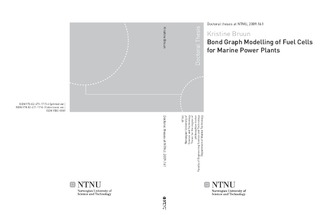| dc.contributor.author | Bruun, Kristine | nb_NO |
| dc.date.accessioned | 2014-12-19T12:05:25Z | |
| dc.date.available | 2014-12-19T12:05:25Z | |
| dc.date.created | 2010-01-04 | nb_NO |
| dc.date.issued | 2009 | nb_NO |
| dc.identifier | 284077 | nb_NO |
| dc.identifier.isbn | 978-82-471-1715-6 (printed ver.) | nb_NO |
| dc.identifier.uri | http://hdl.handle.net/11250/237688 | |
| dc.description.abstract | There is a constant search for alternative solutions improving the fuel efficiency and environmental impact of marine power plants. Fuel cells are regarded as a potential future candidate for significantly reducing pollution from such systems. In this thesis a bond graph template for mathematical modelling of fuel cells is developed. To show the applicability of this template, models of a solid oxide fuel cell (SOFC) system are implemented and simulations carried out. The models are intended for analyses of marine power production in overall ship system applications.
The models developed in this thesis can simulate the transient behaviour of a SOFC. These models are developed from fundamental physical relations, resulting in an improved understanding of the high temperature fuel cell, its possibilities and limitations, in the overall power plant. Fuel cells increase the system complexity, and the template provides an important tool for evaluating system performance under various operating conditions.
Main findings of this thesis are;
Bond graphs are identified as a good tool for the multi-domain nature of fuel cell modelling. Pseudo-bond graphs are chosen to model thermofluid properties while true bond graphs are the choice for electrochemical and electrical domains.
A new bond graph element (R-field) is developed, enabling a straight forward conversion between the thermofluid and electrochemical domains.
By expanding the lumped model approach, a new type of model is developed enabling simulations of distributed characteristics inside the fuel cell. Typical distributed variables of interest are pressure, temperature and concentration of gas components.
The bond graph tool strongly supports the model implementation process when evaluating different ways of representing electrochemical losses. The resulting models are of complete integral causality, lending themselves to computationally efficient system simulations.
Component models of the gas supply system is also developed and implemented, permitting simulations of the fuel cell stack under realistic operating conditions. Both the fuel cell template and the support system components provide a basis for implementing other types of fuel cells using the bond graph language. | nb_NO |
| dc.language | eng | nb_NO |
| dc.publisher | Norges teknisk-naturvitenskapelige universitet, Fakultet for ingeniørvitenskap og teknologi, Institutt for marin teknikk | nb_NO |
| dc.relation.ispartofseries | Doktoravhandlinger ved NTNU, 1503-8181; 2009:161 | nb_NO |
| dc.title | Bond Graph Modelling of Fuel Cells for Marine Power Plants | nb_NO |
| dc.type | Doctoral thesis | nb_NO |
| dc.contributor.department | Norges teknisk-naturvitenskapelige universitet, Fakultet for ingeniørvitenskap og teknologi, Institutt for marin teknikk | nb_NO |
